Coming up with blog titles and generating blog topics can be a real struggle with brainstorming ideas getting you only so far.
When you’ve established yourself as a writer and publish content on a regular basis it’s easy to burn through your original list of topics in a short period.
And this is when you resort to making the one mistake that almost all content writers and creators make – You start focusing on the content ideas and topics that you want to write about. This won’t be counted as a mistake if it is reader-centric and focuses on their questions and problems. But, If this isn’t written with your audience’s problem in mind, they’ll simply stop relying on you.
Thus keeping in mind what your readers care about, here are a few ways to find great blog post ideas that will bring you traffic.
1. Use Google’s auto-suggest
This is one of the easiest, simplest and fastest way to generate blog topics. Here’s what you have to do.
- Open an incognito window.
- Start typing in topics that you are interested in.
And when you do, Google will suggest topics or phrases that people are searching for.
Example: Let’s say that you are a travel agency interested in generating blog topics.
You could type “When to travel to” and here are some of the results you would see.

You could write a post that’s titled “Find the best times to visit the most traveled places on Earth” or write detailed blog posts that deal with a specific destination.
Here’s a bonus option. Use Ubersuggest.
While it isn’t the best tool for generating blog titles, it’s results can give you a general idea of what to write about. Simply enter any word or phrase, and Ubersuggest will give you a long list of results containing the word or phrase followed by some related phrases.

2. Browse Social Animal
Social Animal lets you find trending topics and top shared content over any period of time.
By looking at what people have shared, you get tons of ideas to write about.
The tool also gives you insights like when to post, optimal title and content length, best social media platform to share etc.
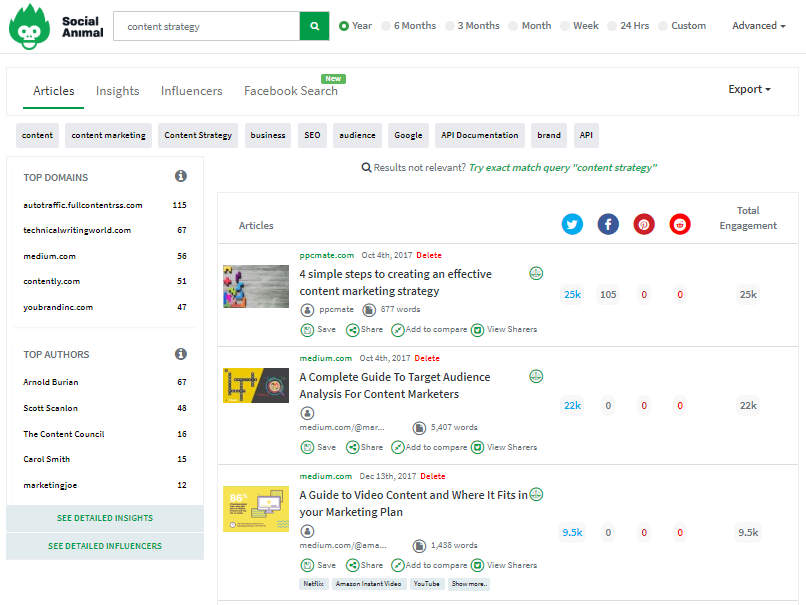
You can also analyze headlines of popularly shared articles to see what has worked and even compare two articles to see what they have in common.
3. Use a Blog topic generator – Seopressor
This blog title generator by SEOPressor, lets you add a keyword and then asks you to clarify the keyword a little by adding a descriptor (brand, event, person, location etc.)
Here’s an example: I typed in ‘Donald Trump’ and qualified the keyword as a person. What I got back was:
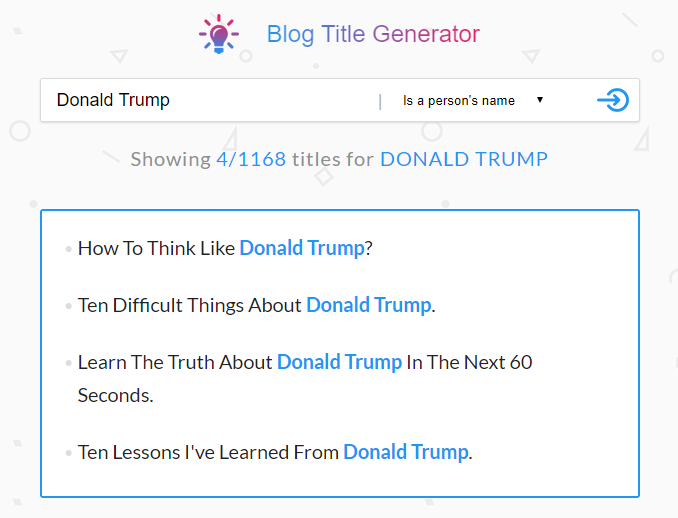
4. Create a survey or a poll and ask your readers
Use SurveyMonkey to ask your readers a list of open-ended questions. Ask your readers what they want to learn, and then you can send it out as an automated email to readers who sign up for your blog updates or as a one-time thing to existing readers on your subscriber list.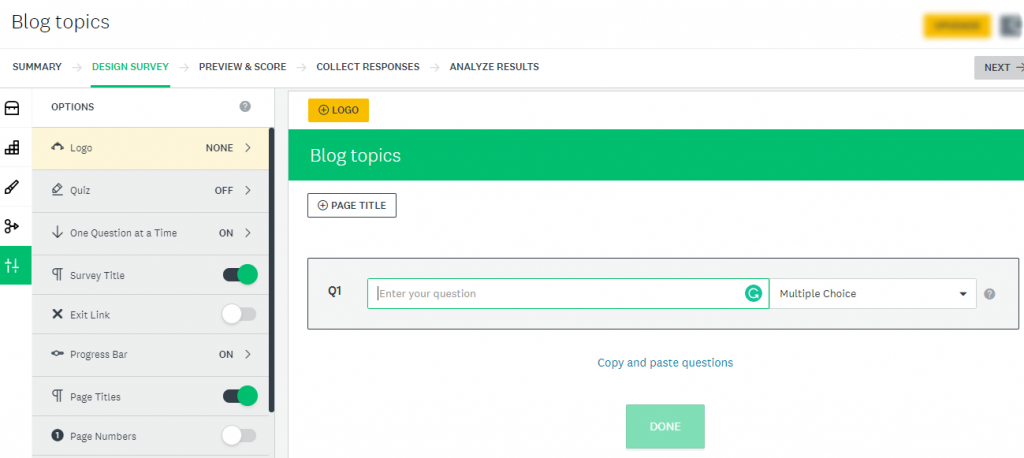
5. Find what’s trending around the world
Google Trends is a free tool that points out how popular certain topics and keywords are.
On the home page, you’ll see some broad topics like the latest game, a trending celebrity or an election. But, you can dig deeper by choosing specific categories, such as business, law or entertainment.
You can also enter a specific keyword and check it’s popularity.

6. Find trending topics/hashtags in social media
Social media platforms like Facebook and Twitter are like goldmines when it comes to looking for ideas and trending topics. Search for topics or keywords related to what you are interested in and take a look at the things people are talking about related to your topic.
Use hashtags along with your keywords to come up with a list of tweets containing your keyword.
If you are on Facebook, then you’ll probably be a member of a few groups pertaining to the niche you work in. If so, then you just need to listen to the questions that are being asked.
Here’s the catch,
These are the questions that they probably google about and also want someone to offer a trustworthy answer.
7. Use Pinterest to Generate the Best Blog Post Ideas
Remember how we talked about creating blogs that are reader-centric and must focus on giving solutions or answers?
And this is where Pinterest comes in as this is a fascinating site entirely dedicated to problems and solutions.
Example: If your blog is about home decor ideas, and you type in “home decor”, Pinterest shows you the most searched for topics relating to your keyword.

Here I see,
- On a Budget
- Apartment
- DIY
- Palets
- Ideas
- And lots more.
While these can’t be considered as topics, they could be categories. When I click on “On a Budget”, I’m presented with even more topics and pins.

You might think that it is pointless to write about topics that somebody else has already written on. But here’s the thing – You could always create a better version of what’s already there. This is called the Skyscraper Technique and it does wonders in generating traffic to your site.
8. Perform a competitor research
Consider using a content marketing tool like Social Animal to analyze your competitor’s top shared posts.
Classify you results based on “Published in the past” and “Shared in the past” filters. Now take a look.
- Are they writing about topics that would interest your audience?
- Can you do a better job? If so, ask yourself how you can improve upon their work.
Example: Find top shared articles from Buzzfeed by typing in “buzzfeed.com” in the query and choose “Shared in the past” from Advanced Filters. Select the time range to display most shared articles.
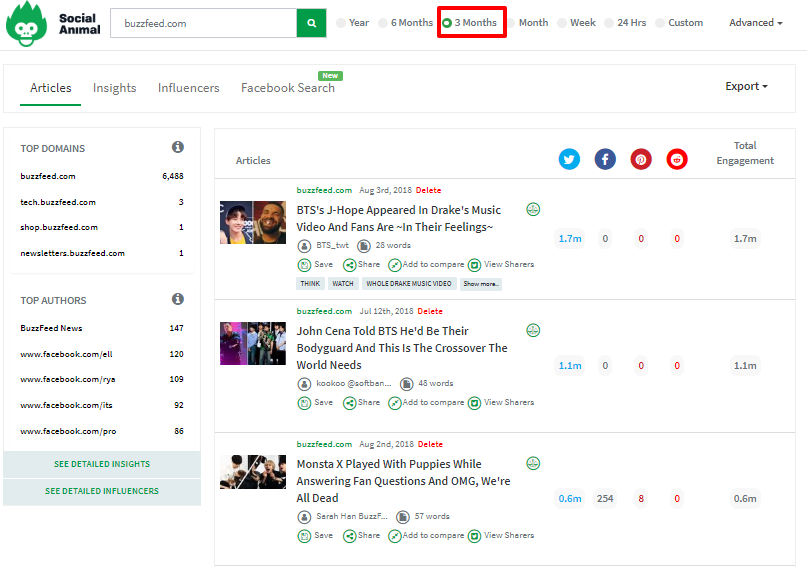
9. Set up Google alerts and monitor your competitors
If you think it’s nearly impossible to stay on top of everything happening in your industry when new information can be released at any moment, you’ll be shocked to see what Google Alerts can do. Set up alerts for specific keywords to see who is regularly appearing on them, as well as branded alerts for your competitors.
You can even customize:
- Whether to track all online mentions for the search query you entered or just track blogs, news, etc.
- How often do you want to receive alerts (as-it-happens, once a day or once a week)
- Track all results or only the best results (the best ones are determined by Google)
- Which email to send the alerts to.
10. Use Google Keyword Planner to discover keywords
Google Keyword Planner is an insanely powerful tool that is a part of Google AdWords and lets you decide on a topic by giving you search volume data.
To discover new keyword ideas just “Enter words, phrases, or a URL related to your business.”
as per Google’s instructions. By using the “Historical Metrics” option you will be able to see 12‐month average search volumes for your keywords.
This is a treasure trove as it shows what people search and want to read about.
11. Keep an eye on local and national holidays
Take a look at unique holidays and observances that happen in a month and craft a piece of content. Make it evergreen so that you can either edit and republish or reshare.
Here’s a list of international days currently observed by the United Nations.
Pick a holiday that can relate to what you do and create slogans, images, infographics, or emails supporting the cause.
Example: Here’s a post that illustrates and elucidates cyber safety and security for children on World Internet Day – October 29, 2017.
12. Reconstruct your old posts
Take time to look at some of your past ideas and posts that aren’t performing well. Select the main keywords from that post and analyze top posts that are ranking for those keywords. Make note of the things that you’ve missed and reconstruct your old posts.
13. Try a different angle for past posts
If you wrote a post about “Best tips” or “Best Practices”, approach your next post in the opposite direction by writing about “Worst Mistakes”.
Andy Crestodina at Orbit Media calls this kind of posts as “The Evil Twins”. He says these posts are easy to produce as you’ve already done your research and all you need to do is take a different angle.
14. Write a Sequel
If you’ve only covered part of a topic, Do a Follow-up post. And, since the new post directly follows the older post, readers will more than likely go to the old one to get caught up.
15. Use HARO (Help a Reporter Out)
HARO lets you get great quality material from outside your circle and you often end up with more material than you can actually deal with. When you become a “reporter” on HARO, you will be allowed to post queries and invite experts, pros, and businesses to pitch their tips, ideas, stories, and quotes.
The result? You get an article alive with examples and real stories.
16. Interview Experts and Influencers
Did you know? Interviews can create timeless content.
Here are the different kinds of posts you can create with expert interviews.
- Informational post
- Case study
- Roundups
- Predictions
- Inspirational post or story
You can publish a post containing the opinions of many experts or get a long interview with one expert, devoting an entire article to them.
Example: Teachable does this with their Change Makers series every week.

17. Read a lot of content from your own niche
If you keep reading blogs, articles, and books you’ll never run out of ideas to write about.
You must also read your blog comments and look for questions your readers might have asked. Answer them in that blog post or simply create a new one. If you don’t get many comments or if you’ve turned them off, visit a popular competitor blog that’s read by your audience.
18. Take Notes when you read and brainstorm
You should develop the quality to take notes on just about everything when you brainstorm and read around the web. Dump every single idea that you get on a Trello board.
When used correctly, brainstorming can generate a lot of quality topics in a short period.
Associative brainstorming is simple to perform and can help you climb out of this rut. It uses word association to get you thinking outside the box.
Think of a keyword that relates to what you want to write about. Jot down all the words that pop up when you think of this keyword. Jot it down on a note or use a free tool like Bubble.us to map it all.
Here’s an example.
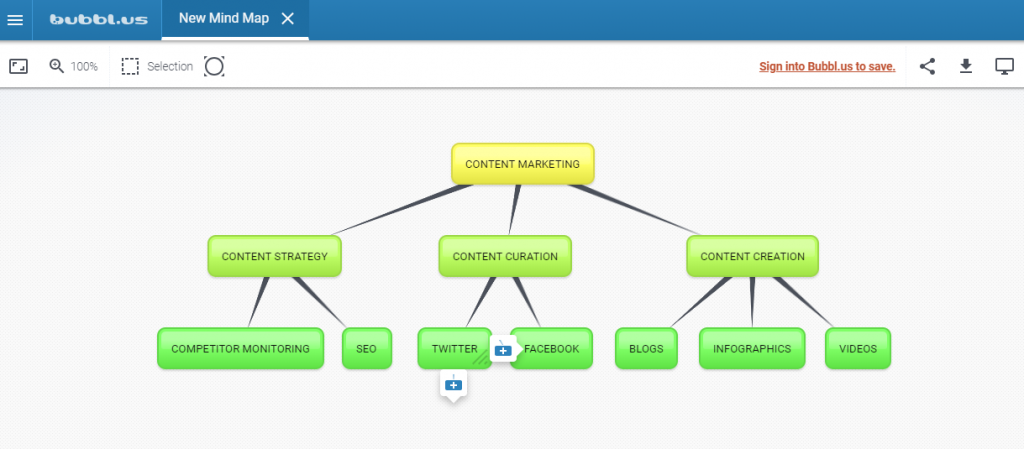
Now, try to form headlines using these word associations. Like this,
- Why you should monitor competitors to develop a killer content strategy?
- How to use Content Curation to quickly grow on Twitter?
- Why Infographics are better than written content?
This took about 5 minutes. So, now you know how that you can generate lots more in an hour.
19. Write about things that no one wants to write about
When you are a writer, your mind will tell you to avoid writing controversial content. But, the truth is, controversy sells.
Keep in mind that when you write controversial content, you run the risk of driving your readers away, damaging your brand’s reputation, and even losing your business.
So what should you do?
- Get your facts straight.
- Be bold but point out that your opinion is just one view on the topic.
- Maintain a tone that is humorous. (Taking a humorous slant reduces the sting)
20. Check out questions that people are asking in Quora and Yahoo answers
An estimate says there are nearly 11 million questions asked on Quora. Use Quora and Yahoo answers to search for topics or keywords related to what you want to write about. Focus on the questions asked by people and then create an extensive guide that offers a solution.

These strategies work in just about every industry and niche.
Thus, Coming up with great new ideas for blog posts is really not hard if you know where and what to look for.
With luck, you now have a sense of what to do to accomplish the great task of generating blog topics.
And all it takes is an hour.


